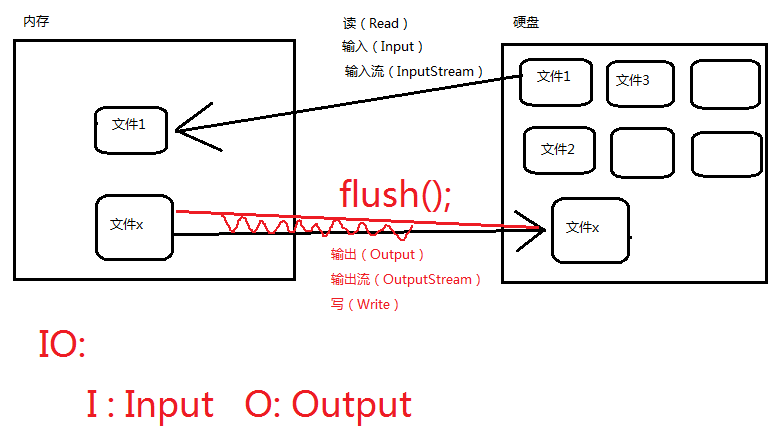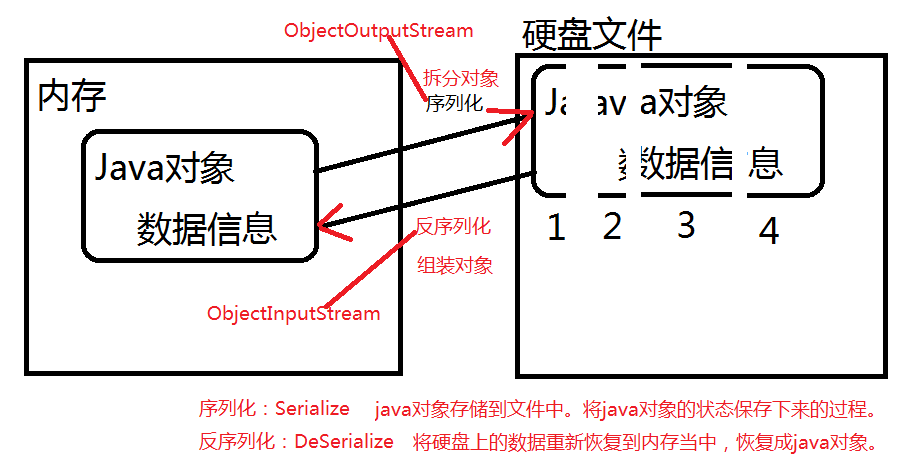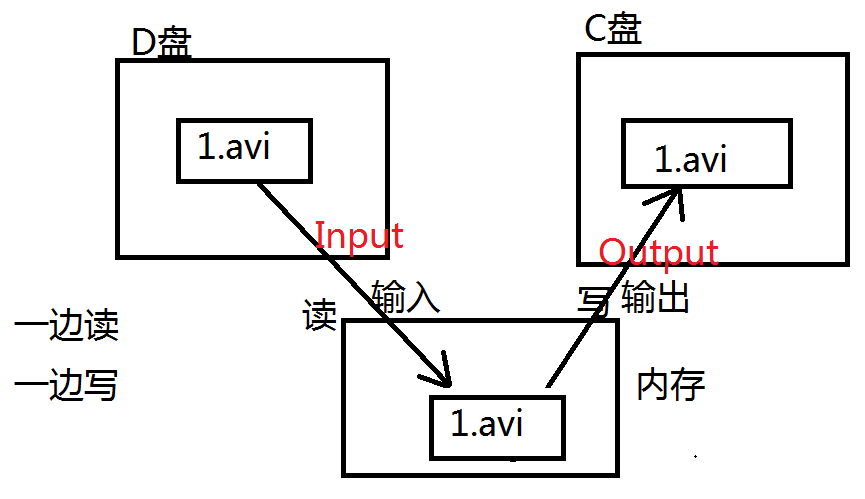第十八章 IO流
1. IO流基本概念
1.1 什么是IO

需注意IO是建立在内存与硬盘之间的
1.2 IO流的分类
- 一种方式是按照流的方向进行分类:
以内存作为参照物,往内存中去,叫做输入(Input)。或者叫做读(Read);从内存中出来,叫做输出(Output)。或者叫做写(Write)。
- 另一种方式是按照读取数据方式不同进行分类:
有的流是按照字节的方式读取数据,一次读取1个字节byte,等同于一次读取8个二进制位。这种流是万能的,什么类型的文件都可以读取。包括:文本文件,图片,声音文件,视频文件等….
- 综上所述:流的分类
输入流、输出流、字节流、字符流
- java中所有的流都是在:java.io.*
假设文件file1.txt,采用字节流的话是这样读的:a中国bc张三fe第一次读:一个字节,正好读到'a'第二次读:一个字节,正好读到'中'字符的一半。第三次读:一个字节,正好读到'中'字符的另外一半。有的流是按照字符的方式读取数据的,一次读取一个字符,这种流是为了方便读取普通文本文件而存在的,这种流不能读取:图片、声音、视频等文件。只能读取纯文本文件,连word文件都无法读取。假设文件file1.txt,采用字符流的话是这样读的:a中国bc张三fe第一次读:'a'字符('a'字符在windows系统中占用1个字节。)第二次读:'中'字符('中'字符在windows系统中占用2个字节。)
1.2.1 java IO流的四大家族
- 四大家族的首领:
java.io.InputStream 字节输入流
java.io.OutputStream 字节输出流
java.io.Reader 字符输入流
java.io.Writer 字符输出流
- 四大家族的首领都是**抽象类**。(abstract class)
所有的流都实现了:java.io.Closeable接口(可关闭的,有close()方法)
流毕竟是一个管道,这个是内存和硬盘之间的通道,用完之后一定要关闭,不然会耗费(占用)很多资源。养成好习惯,用完流一定要关闭。
所有的输出流都实现了:java.io.Flushable接口(可刷新的,有flush()方法)
养成一个好习惯,输出流在最终输出之后,一定要记得flush(),刷新一下。这个刷新表示将通道/管道当中剩余未输出的数据强行输出完(清空管道!)刷新的作用就是清空管道。
注意: 如果没有flush()可能会导致丢失数据。 在java中只要“类名”以Stream结尾的都是字节流。以“Reader/Writer”结尾的都是字符流。
1.2.2 java.io包下需要掌握的16个流
文件专属:
java.io.FileInputStream(掌握) 万能的,任何类型的文件都可以采用这个流来读。
java.io.FileOutputStream(掌握)
java.io.FileReader
java.io.FileWriter
转换流:(将字节流转换成字符流)
java.io.InputStreamReader
java.io.OutputStreamWriter
缓冲流专属:
java.io.BufferedReader
java.io.BufferedWriter
java.io.BufferedInputStream
java.io.BufferedOutputStream
数据流专属:
java.io.DataInputStream
java.io.DataOutputStream
标准输出流:
java.io.PrintWriter
java.io.PrintStream(掌握)
对象专属流:
java.io.ObjectInputStream(掌握)
java.io.ObjectOutputStream(掌握)
2. FileInputStream
2.1 基本格式
public class FileInputStreamTest04 {public static void main(String[] args) {FileInputStream fis = null;try {fis = new FileInputStream("chapter23/src/tempfile3");// 准备一个byte数组byte[] bytes = new byte[4];/*while(true){int readCount = fis.read(bytes);if(readCount == -1){break;}// 把byte数组转换成字符串,读到多少个转换多少个。System.out.print(new String(bytes, 0, readCount));}*/int readCount = 0;while((readCount = fis.read(bytes)) != -1) {System.out.print(new String(bytes, 0, readCount));}} catch (FileNotFoundException e) {e.printStackTrace();} catch (IOException e) {e.printStackTrace();} finally {if (fis != null) {try {fis.close();} catch (IOException e) {e.printStackTrace();}}}}}
需注意idea的当前路径是project目录,相对路径是建立在project目录下的
2.2 FileinputStream其他方法
/*FileInputStream类的其它常用方法:int available():返回流当中剩余的没有读到的字节数量long skip(long n):跳过几个字节不读。*/public class FileInputStreamTest05 {public static void main(String[] args) {FileInputStream fis = null;try {fis = new FileInputStream("tempfile");System.out.println("总字节数量:" + fis.available());// 读1个字节//int readByte = fis.read();// 还剩下可以读的字节数量是:5//System.out.println("剩下多少个字节没有读:" + fis.available());// 这个方法有什么用?//byte[] bytes = new byte[fis.available()]; // 这种方式不太适合太大的文件,因为byte[]数组不能太大。// 不需要循环了。// 直接读一次就行了。//int readCount = fis.read(bytes); // 6//System.out.println(new String(bytes)); // abcdef// skip跳过几个字节不读取,这个方法也可能以后会用!fis.skip(3);System.out.println(fis.read()); //100} catch (FileNotFoundException e) {e.printStackTrace();} catch (IOException e) {e.printStackTrace();} finally {if (fis != null) {try {fis.close();} catch (IOException e) {e.printStackTrace();}}}}}
3. FileOutputStream
public class FileOutputStreamTest01 {public static void main(String[] args) {FileOutputStream fos = null;try {// myfile文件不存在的时候会自动新建!// 这种方式谨慎使用,这种方式会先将原文件清空,然后重新写入。//fos = new FileOutputStream("myfile");//fos = new FileOutputStream("chapter23/src/tempfile3");// 以追加的方式在文件末尾写入。不会清空原文件内容。fos = new FileOutputStream("chapter23/src/tempfile3", true);// 开始写。byte[] bytes = {97, 98, 99, 100};// 将byte数组全部写出!fos.write(bytes); // abcd// 将byte数组的一部分写出!fos.write(bytes, 0, 2); // 再写出ab// 字符串String s = "我是一个中国人,我骄傲!!!";// 将字符串转换成byte数组。byte[] bs = s.getBytes();// 写fos.write(bs);// 写完之后,最后一定要刷新fos.flush();} catch (FileNotFoundException e) {e.printStackTrace();} catch (IOException e) {e.printStackTrace();} finally {if (fos != null) {try {fos.close();} catch (IOException e) {e.printStackTrace();}}}}}
3.1 文件复制
3.1.1 文件复制过程
3.1.2 代码分析
/*使用FileInputStream + FileOutputStream完成文件的拷贝。拷贝的过程应该是一边读,一边写。使用以上的字节流拷贝文件的时候,文件类型随意,万能的。什么样的文件都能拷贝。*/public class Copy01 {public static void main(String[] args) {FileInputStream fis = null;FileOutputStream fos = null;try {// 创建一个输入流对象fis = new FileInputStream("D:\\course\\02-JavaSE\\video\\chapter01\\动力节点-JavaSE-杜聚宾-001-文件扩展名的显示.avi");// 创建一个输出流对象fos = new FileOutputStream("C:\\动力节点-JavaSE-杜聚宾-001-文件扩展名的显示.avi");// 最核心的:一边读,一边写byte[] bytes = new byte[1024 * 1024]; // 1MB(一次最多拷贝1MB。)int readCount = 0;while((readCount = fis.read(bytes)) != -1) {fos.write(bytes, 0, readCount);}// 刷新,输出流最后要刷新fos.flush();} catch (FileNotFoundException e) {e.printStackTrace();} catch (IOException e) {e.printStackTrace();} finally {// 分开try,不要一起try。// 一起try的时候,其中一个出现异常,可能会影响到另一个流的关闭。if (fos != null) {try {fos.close();} catch (IOException e) {e.printStackTrace();}}if (fis != null) {try {fis.close();} catch (IOException e) {e.printStackTrace();}}}}}
4. FileReader
/*FileReader:文件字符输入流,只能读取普通文本。读取文本内容时,比较方便,快捷。*/public class FileReaderTest {public static void main(String[] args) {FileReader reader = null;try {// 创建文件字符输入流reader = new FileReader("tempfile");//准备一个char数组char[] chars = new char[4];// 往char数组中读reader.read(chars); // 按照字符的方式读取:第一次e,第二次f,第三次 风....for(char c : chars) {System.out.println(c);}/*// 开始读char[] chars = new char[4]; // 一次读取4个字符int readCount = 0;while((readCount = reader.read(chars)) != -1) {System.out.print(new String(chars,0,readCount));}*/} catch (FileNotFoundException e) {e.printStackTrace();} catch (IOException e) {e.printStackTrace();} finally {if (reader != null) {try {reader.close();} catch (IOException e) {e.printStackTrace();}}}}}
5. FileWriter
/*FileWriter:文件字符输出流。写。只能输出普通文本。*/public class FileWriterTest {public static void main(String[] args) {FileWriter out = null;try {// 创建文件字符输出流对象//out = new FileWriter("file");out = new FileWriter("file", true);// 开始写。char[] chars = {'我','是','中','国','人'};out.write(chars);out.write(chars, 2, 3);out.write("我是一名java软件工程师!");// 写出一个换行符。out.write("\n");out.write("hello world!");// 刷新out.flush();} catch (IOException e) {e.printStackTrace();} finally {if (out != null) {try {out.close();} catch (IOException e) {e.printStackTrace();}}}}}
5.1 复制普通文本文件
/*使用FileReader FileWriter进行拷贝的话,只能拷贝“普通文本”文件。*/public class Copy02 {public static void main(String[] args) {FileReader in = null;FileWriter out = null;try {// 读in = new FileReader("chapter23/src/com/bjpowernode/java/io/Copy02.java");// 写out = new FileWriter("Copy02.java");// 一边读一边写:char[] chars = new char[1024 * 512]; // 1MBint readCount = 0;while((readCount = in.read(chars)) != -1){out.write(chars, 0, readCount);}// 刷新out.flush();} catch (FileNotFoundException e) {e.printStackTrace();} catch (IOException e) {e.printStackTrace();} finally {if (in != null) {try {in.close();} catch (IOException e) {e.printStackTrace();}}if (out != null) {try {out.close();} catch (IOException e) {e.printStackTrace();}}}}}
6. BufferedReader
/*BufferedReader:带有缓冲区的字符输入流。使用这个流的时候不需要自定义char数组,或者说不需要自定义byte数组。自带缓冲。*/public class BufferedReaderTest01 {public static void main(String[] args) throws Exception{FileReader reader = new FileReader("Copy02.java");// 当一个流的构造方法中需要一个流的时候,这个被传进来的流叫做:节点流。// 外部负责包装的这个流,叫做:包装流,还有一个名字叫做:处理流。// 像当前这个程序来说:FileReader就是一个节点流。BufferedReader就是包装流/处理流。BufferedReader br = new BufferedReader(reader);// 读一行/*String firstLine = br.readLine();System.out.println(firstLine);String secondLine = br.readLine();System.out.println(secondLine);String line3 = br.readLine();System.out.println(line3);*/// br.readLine()方法读取一个文本行,但不带换行符。String s = null;while((s = br.readLine()) != null){System.out.print(s);}// 关闭流// 对于包装流来说,只需要关闭最外层流就行,里面的节点流会自动关闭。(可以看源代码。)br.close();}}
7. InputStreamReader
/*转换流:InputStreamReader*/public class BufferedReaderTest02 {public static void main(String[] args) throws Exception{/*// 字节流FileInputStream in = new FileInputStream("Copy02.java");// 通过转换流转换(InputStreamReader将字节流转换成字符流。)// in是节点流。reader是包装流。InputStreamReader reader = new InputStreamReader(in);// 这个构造方法只能传一个字符流。不能传字节流。// reader是节点流。br是包装流。BufferedReader br = new BufferedReader(reader);*/// 合并BufferedReader br = new BufferedReader(new InputStreamReader(new FileInputStream("Copy02.java")));String line = null;while((line = br.readLine()) != null){System.out.println(line);}// 关闭最外层br.close();}}
8. BufferedWriter
/*BufferedWriter:带有缓冲的字符输出流。OutputStreamWriter:转换流*/public class BufferedWriterTest {public static void main(String[] args) throws Exception{// 带有缓冲区的字符输出流//BufferedWriter out = new BufferedWriter(new FileWriter("copy"));BufferedWriter out = new BufferedWriter(new OutputStreamWriter(new FileOutputStream("copy", true)));// 开始写。out.write("hello world!");out.write("\n");out.write("hello kitty!");// 刷新out.flush();// 关闭最外层out.close();}}
9. DataInputStream
/*DataInputStream:数据字节输入流。DataOutputStream写的文件,只能使用DataInputStream去读。并且读的时候你需要提前知道写入的顺序。读的顺序需要和写的顺序一致。才可以正常取出数据。*/public class DataInputStreamTest01 {public static void main(String[] args) throws Exception{DataInputStream dis = new DataInputStream(new FileInputStream("data"));// 开始读byte b = dis.readByte();short s = dis.readShort();int i = dis.readInt();long l = dis.readLong();float f = dis.readFloat();double d = dis.readDouble();boolean sex = dis.readBoolean();char c = dis.readChar();System.out.println(b);System.out.println(s);System.out.println(i + 1000);System.out.println(l);System.out.println(f);System.out.println(d);System.out.println(sex);System.out.println(c);dis.close();}}
10. DataOutputStream
/*java.io.DataOutputStream:数据专属的流。这个流可以将数据连同数据的类型一并写入文件。注意:这个文件不是普通文本文档。(这个文件使用记事本打不开。)*/public class DataOutputStreamTest {public static void main(String[] args) throws Exception{// 创建数据专属的字节输出流DataOutputStream dos = new DataOutputStream(new FileOutputStream("data"));// 写数据byte b = 100;short s = 200;int i = 300;long l = 400L;float f = 3.0F;double d = 3.14;boolean sex = false;char c = 'a';// 写dos.writeByte(b); // 把数据以及数据的类型一并写入到文件当中。dos.writeShort(s);dos.writeInt(i);dos.writeLong(l);dos.writeFloat(f);dos.writeDouble(d);dos.writeBoolean(sex);dos.writeChar(c);// 刷新dos.flush();// 关闭最外层dos.close();}}
11. PrintStream
/*java.io.PrintStream:标准的字节输出流。默认输出到控制台。*/public class PrintStreamTest {public static void main(String[] args) throws Exception{// 联合起来写System.out.println("hello world!");// 分开写PrintStream ps = System.out;ps.println("hello zhangsan");ps.println("hello lisi");ps.println("hello wangwu");// 标准输出流不需要手动close()关闭。// 可以改变标准输出流的输出方向吗? 可以/*// 这些是之前System类使用过的方法和属性。System.gc();System.currentTimeMillis();PrintStream ps2 = System.out;System.exit(0);System.arraycopy(....);*/// 标准输出流不再指向控制台,指向“log”文件。PrintStream printStream = new PrintStream(new FileOutputStream("log"));// 修改输出方向,将输出方向修改到"log"文件。System.setOut(printStream);// 再输出System.out.println("hello world");System.out.println("hello kitty");System.out.println("hello zhangsan");}}
11.1 日志工具
/*日志工具*/public class Logger {/*记录日志的方法。*/public static void log(String msg) {try {// 指向一个日志文件PrintStream out = new PrintStream(new FileOutputStream("log.txt", true));// 改变输出方向System.setOut(out);// 日期当前时间Date nowTime = new Date();SimpleDateFormat sdf = new SimpleDateFormat("yyyy-MM-dd HH:mm:ss SSS");String strTime = sdf.format(nowTime);System.out.println(strTime + ": " + msg);} catch (FileNotFoundException e) {e.printStackTrace();}}}
12. File
12.1 File类概述
- **File类和四大家族没有关系**,所以**File类不能完成文件的读和写**。- File对象代表什么?**文件和目录路径名的抽象表示形式**。<br /> C:\Drivers 这是一个File对象<br /> C:\Drivers\Lan\Realtek\Readme.txt 也是File对象。<br /> 一个File对象有可能对应的是目录,也可能是文件。<br /> File只是一个路径名的抽象表示形式。
public class FileTest01 {public static void main(String[] args) throws Exception {// 创建一个File对象File f1 = new File("D:\\file");// 判断是否存在!System.out.println(f1.exists());// 如果D:\file不存在,则以文件的形式创建出来/*if(!f1.exists()) {// 以文件形式新建f1.createNewFile();}*/// 如果D:\file不存在,则以目录的形式创建出来/*if(!f1.exists()) {// 以目录的形式新建。f1.mkdir();}*/// 可以创建多重目录吗?File f2 = new File("D:/a/b/c/d/e/f");/*if(!f2.exists()) {// 多重目录的形式新建。f2.mkdirs();}*/File f3 = new File("D:\\course\\01-开课\\学习方法.txt");// 获取文件的父路径String parentPath = f3.getParent();System.out.println(parentPath); //D:\course\01-开课File parentFile = f3.getParentFile();System.out.println("获取绝对路径:" + parentFile.getAbsolutePath());File f4 = new File("copy");System.out.println("绝对路径:" + f4.getAbsolutePath()); // C:\Users\Administrator\IdeaProjects\javase\copy}}
12.2 File类其它常用方法
public class FileTest02 {public static void main(String[] args) {File f1 = new File("D:\\course\\01-开课\\开学典礼.ppt");// 获取文件名System.out.println("文件名:" + f1.getName());// 判断是否是一个目录System.out.println(f1.isDirectory()); // false// 判断是否是一个文件System.out.println(f1.isFile()); // true// 获取文件最后一次修改时间long haoMiao = f1.lastModified(); // 这个毫秒是从1970年到现在的总毫秒数。// 将总毫秒数转换成日期?????Date time = new Date(haoMiao);SimpleDateFormat sdf = new SimpleDateFormat("yyyy-MM-dd HH:mm:ss SSS");String strTime = sdf.format(time);System.out.println(strTime);// 获取文件大小System.out.println(f1.length()); //216064字节。}}
/*File中的listFiles方法。*/public class FileTest03 {public static void main(String[] args) {// File[] listFiles()// 获取当前目录下所有的子文件。File f = new File("D:\\course\\01-开课");File[] files = f.listFiles();// foreachfor(File file : files){//System.out.println(file.getAbsolutePath());System.out.println(file.getName());}}}
13. 序列化和反序列化
13.1 序列化

1、java.io.NotSerializableException:对象不支持序列化!!!!
2、参与序列化和反序列化的对象,必须实现Serializable接口。
3、注意:通过源代码发现,Serializable接口只是一个标志接口:
public interface Serializable {}
这个接口当中什么代码都没有,那么它起到一个什么作用呢? 起到标识的作用,标志的作用,java虚拟机看到这个类实现了这个接口,可能会对这个类进行特殊待遇,Serializable这个标志接口是给java虚拟机参考的,java虚拟机看到这个接口之后,会为该类自动生成一个序列化版本号。
4、序列化版本号有什么用呢?
java.io.InvalidClassException:com.bjpowernode.java.bean.Student;
local class incompatible:
stream classdesc serialVersionUID = -684255398724514298(十年后),local class serialVersionUID = -3463447116624555755(十年前)
java语言中是采用什么机制来区分类的?
第一:首先通过类名进行比对,如果类名不一样,肯定不是同一个类。
第二:如果类名一样,再怎么进行类的区别?靠序列化版本号进行区分。
小鹏编写了一个类:com.bjpowernode.java.bean.Student implements Serializable,胡浪编写了一个类:com.bjpowernode.java.bean.Student implements Serializable,不同的人编写了同一个类,但“这两个类确实不是同一个类”。这个时候序列化版本就起上作用了。对于java虚拟机来说,java虚拟机是可以区分开这两个类的,因为这两个类都实现了Serializable接口,都有默认的序列化版本号,他们的序列化版本号不一样。所以区分开了。(这是自动生成序列化版本号的好处)
这种自动生成序列化版本号有什么缺陷? 这种自动生成的序列化版本号缺点是:一旦代码确定之后,不能进行后续的修改,因为只要修改,必然会重新编译,此时会生成全新的序列化版本号,这个时候java虚拟机会认为这是一个全新的类。(这样就不好了!)
5、最终结论:
凡是一个类实现了Serializable接口,建议给该类提供一个固定不变的序列化版本号,这样,以后这个类即使代码修改了,但是版本号不变,java虚拟机会认为是同一个类。
public class ObjectOutputStreamTest01 {public static void main(String[] args) throws Exception{// 创建java对象Student s = new Student(1111, "zhangsan");// 序列化ObjectOutputStream oos = new ObjectOutputStream(new FileOutputStream("students"));// 序列化对象oos.writeObject(s);// 刷新oos.flush();// 关闭oos.close();}}
/*一次序列化多个对象呢?可以,可以将对象放到集合当中,序列化集合。提示:参与序列化的ArrayList集合以及集合中的元素User都需要实现 java.io.Serializable接口。*/public class ObjectOutputStreamTest02 {public static void main(String[] args) throws Exception{List<User> userList = new ArrayList<>();userList.add(new User(1,"zhangsan"));userList.add(new User(2, "lisi"));userList.add(new User(3, "wangwu"));ObjectOutputStream oos = new ObjectOutputStream(new FileOutputStream("users"));// 序列化一个集合,这个集合对象中放了很多其他对象。oos.writeObject(userList);oos.flush();oos.close();}}
13.1.1 transient关键字
import java.io.Serializable;public class User implements Serializable {private int no;// transient关键字表示游离的,不参与序列化。private transient String name; // name不参与序列化操作!public User() {}public User(int no, String name) {this.no = no;this.name = name;}@Overridepublic String toString() {return "User{" +"no=" + no +", name='" + name + '\'' +'}';}public int getNo() {return no;}public void setNo(int no) {this.no = no;}public String getName() {return name;}public void setName(String name) {this.name = name;}}
13.1.2 序列化版本号
import java.io.Serializable;public class Student implements Serializable {// IDEA工具自动生成序列化版本号。//private static final long serialVersionUID = -7998917368642754840L;// Java虚拟机看到Serializable接口之后,会自动生成一个序列化版本号。// 这里没有手动写出来,java虚拟机会默认提供这个序列化版本号。// 建议将序列化版本号手动的写出来。不建议自动生成private static final long serialVersionUID = 1L; // java虚拟机识别一个类的时候先通过类名,如果类名一致,再通过序列化版本号。private int no;//private String name;// 过了很久,Student这个类源代码改动了。// 源代码改动之后,需要重新编译,编译之后生成了全新的字节码文件。// 并且class文件再次运行的时候,java虚拟机生成的序列化版本号也会发生相应的改变。private int age;private String email;private String address;public Student() {}public Student(int no, String name) {this.no = no;//this.name = name;}public int getNo() {return no;}public void setNo(int no) {this.no = no;}/*public String getName() {return name;}*//*public void setName(String name) {this.name = name;}*//*@Overridepublic String toString() {return "Student{" +"no=" + no +", name='" + name + '\'' +'}';}*/@Overridepublic String toString() {return "Student{" +"no=" + no +", age=" + age +", email='" + email + '\'' +", address='" + address + '\'' +'}';}}
13.2 反序列化
public class ObjectInputStreamTest01 {public static void main(String[] args) throws Exception{ObjectInputStream ois = new ObjectInputStream(new FileInputStream("students"));// 开始反序列化,读Object obj = ois.readObject();// 反序列化回来是一个学生对象,所以会调用学生对象的toString方法。System.out.println(obj);ois.close();}}
/*反序列化集合*/public class ObjectInputStreamTest02 {public static void main(String[] args) throws Exception{ObjectInputStream ois = new ObjectInputStream(new FileInputStream("users"));//Object obj = ois.readObject();//System.out.println(obj instanceof List);List<User> userList = (List<User>)ois.readObject();for(User user : userList){System.out.println(user);}ois.close();}}
14. IO+Properties的联合应用
import java.io.FileReader;import java.util.Properties;/*IO+Properties的联合应用。非常好的一个设计理念:以后经常改变的数据,可以单独写到一个文件中,使用程序动态读取。将来只需要修改这个文件的内容,java代码不需要改动,不需要重新编译,服务器也不需要重启。就可以拿到动态的信息。类似于以上机制的这种文件被称为配置文件。并且当配置文件中的内容格式是:key1=valuekey2=value的时候,我们把这种配置文件叫做属性配置文件。java规范中有要求:属性配置文件建议以.properties结尾,但这不是必须的。这种以.properties结尾的文件在java中被称为:属性配置文件。其中Properties是专门存放属性配置文件内容的一个类。*/public class IoPropertiesTest01 {public static void main(String[] args) throws Exception{/*Properties是一个Map集合,key和value都是String类型。想将userinfo文件中的数据加载到Properties对象当中。*/// 新建一个输入流对象FileReader reader = new FileReader("chapter23/userinfo.properties");// 新建一个Map集合Properties pro = new Properties();// 调用Properties对象的load方法将文件中的数据加载到Map集合中。pro.load(reader); // 文件中的数据顺着管道加载到Map集合中,其中等号=左边做key,右边做value// 通过key来获取value呢?String username = pro.getProperty("username");System.out.println(username);String password = pro.getProperty("password");System.out.println(password);String data = pro.getProperty("data");System.out.println(data);String usernamex = pro.getProperty("usernamex");System.out.println(usernamex);}}
14.1 properties文件书写
- 建议key和value之间使用=的方式。- =左边是key,=右边是value- 在属性配置文件中井号(#)是注释- 属性配置文件的key重复的话,value会自动覆盖!- 最好不要有空格
data = abc
- 不建议使用冒号( : ),所以最好直接用 =


